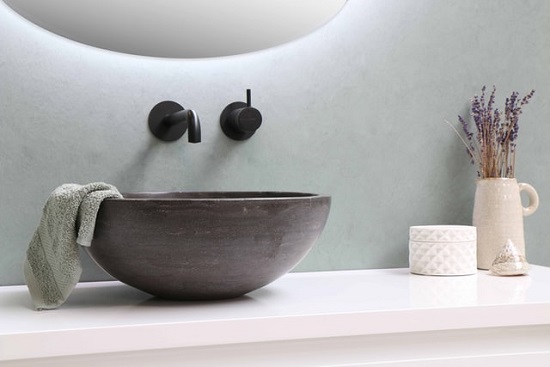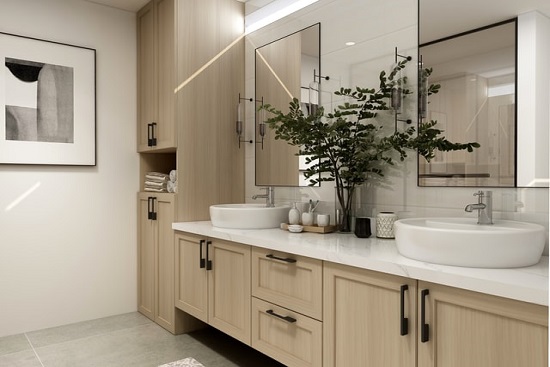The topic of how far should a tap hang over a basin is something that most homeowners aren’t particularly concerned about. However, the truth of the matter is that the distance between wall mounted tap and basin is an important consideration because it dictates the water spouts and splatters once it hits the surface of the wall mounted basin.
If how much space for wall mounted taps is indeed your concern, then you would be glad to know that the article I have prepared for today is specially published to cater to your needs.
So without further ado, let’s begin discussing how far should a tap hang over a basin…
- Where to Start in Determining the Basin Tap Height
- Choices of Wall Mounted Basins
- Standard/Functional Measurement for Basin Tap Height

Where to Start in Determining the Basin Tap Height
Before we consider everything else in covering how much space for wall mounted taps are needed, it is highly important that we have to take note of several factors, first and foremost, to make the procedure a lot more convenient, if you will.
For instance, we have to take into consideration the type and design of the faucet you’re going to opt for your wall mounted basin. Remember that each form of faucet varies in height and water pressure it can emit. So the question of starting begins with measuring the desired basin tap height firstly and then identifying how much space for wall mounted taps from the surface of the basin.
So what this means is that you have to gather the correct measurements using a retractable tape measure. If you are not sure about the distance between wall tap and basin, you can always seek the aid of a professional or a plumber, so to speak.
Choices of Wall Mounted Basins
The basic purpose of a bathroom sink is for proper hygiene, such as hand washing, rinsing your face with others, brushing your teeth, removing makeup, etc.
With this being said—you need to have the right proportion of height from the base of the floorings to the basin tap and then from the faucet down to the surface sink.
And if you are still not sure of the proper rise of the basin, then below are four of the common types of bathroom faucet levels used in the vicinity and their prominent features—
High Spout
High spout faucets typically have a rise of 25cm or higher, considering the wall mounted tap height above basin. They are the perfect choice if the faucets aren’t only intended for the adults of your household. They are high enough, which makes them easier for the child to reach a faucet and do their regular grooming routine.
Low and Medium Spout
Water taps labeled as low and medium spouts are with the ranges of 12cm to 15cm and 15cm to 25cm for low to medium wall mounted tap height above basin, respectively. This is the traditional faucet that you typically find in the bathroom. They are excellent for regular bathroom routines such as washing your hands and other hygienic purposes like face washing, makeup removal, etc.
Long Spout
A long spout is those with a long and curving snout. This type of faucet has an average of 21cm and a depth that usually reaches 25 cm. As you can see, it is not exactly a typical bathroom. These are the ones you will usually see in communal baths.
In a private home, they may be useful when you have a wide bathroom sink. What it does is that it basically accommodates the range of spouts in accordance with the size of the basin.
Short Spout
On the other hand, a short spout is ideal for bathroom basins with a stiff width basin and small bathroom space, in general. A short spout basically has a depth of 15cm in considering how far should a tap hang over basin.
Standard/Functional Measurement for Basin Tap Height
Now, I will walk you through the three crucial steps in a standard measure of the wall mounted tap height above basin and other factors you have to keep in mind—
First Step: Record the Accurate Measurement As Much As Possible
The desired basin tap height should take into consideration the average of the family if it’s a shared bathroom. But if for a specific member of the family, then the distance between wall mounted tap and basin and basically, its overall rise should be at a level you’re comfortable with.
Second Step: Record the Measurement of Faucet Installation Line to the Water Outlet
Another measurement that we have to take note of is the measurement of distance between the bathroom water outlets to the faucet. Getting the proper measurement prevents the faucet from dangling, which would lead to inconsistent water pressures and spouts.
Third Step: Take the Records to the Shop
Now that you have the proper measurement of the wall mounted basin, you can take your records to your local home depot for assistance. In addition, they can also provide you with their insights into the subject matter in order for you to perfect your endeavor.

Takeaway
Aside from the apparent aesthetics of the taps, determining the height of the fixture is an essential factor to consider if you want your regular hygienic routine to be as comfortable as possible.
If you are not sure about the level or the rise of the basin, you can always use the types of spouts I have listed in today’s discussion to help you determine how much space for wall mounted taps you can opt for.
Frequently Asked Questions about How Far Should a Tap Hang Over a Basin
The following are additional concerns that many people have about the subject matter of how far should a tap hang over a basin:
To get the optimum comfort as you are conducting your daily bathroom routine, you need to consider, first and foremost, the average of the people using the vicinity on a regular basis.
You have to bear in mind that a basin that’s too high will have an uncomfortable reach to the tap for people with a below-average height and vice versa.
The ideal concept here is that it should go directly over the drain. Remember that the faucet is typically on the back end of the sink rim if the tap is a drop type, or it could be farther back if it’s a deck mount type.
0 Comments for “The Perfect Distance of How Far Should a Tap Hang Over a Basin”